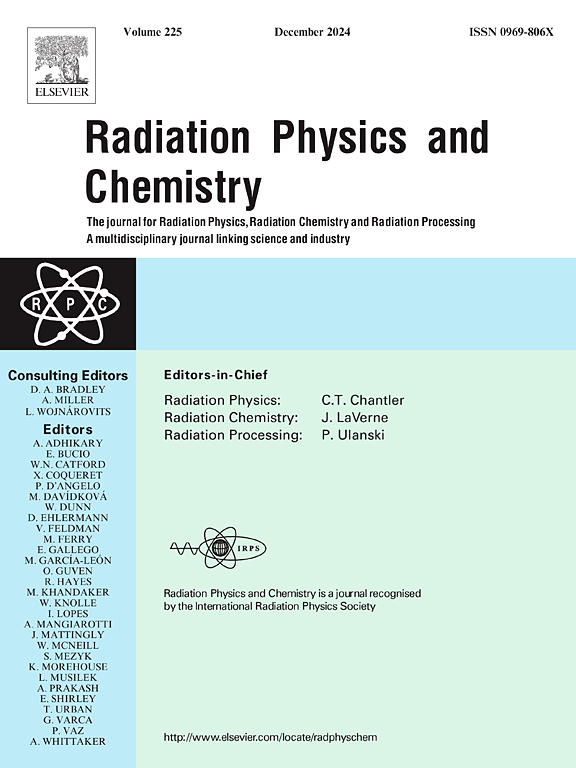(G4-SEOPTIM):用于屏蔽外壳、设计和屏蔽优化的 GEANT4 应用程序:摩洛哥新型屏蔽外壳案例
IF 2.8
3区 物理与天体物理
Q3 CHEMISTRY, PHYSICAL
引用次数: 0
摘要
目的本研究旨在使用最新的 G4RadioactiveDecayPhysics v5.1 库开发和验证 Geant4 仿真应用程序,以优化摩洛哥屏蔽罩的屏蔽设计。目标是通过比较仿真结果和基于衰减定律(比尔-朗伯定律)的初始几何计算结果,确保有效的辐射防护,并实施设计优化,以提高安全性和降低成本。研究开始时,原型设计基于线性衰减计算,成本高昂,对患者的安全性有限。我们使用 Geant4 蒙特卡罗工具包模拟了屏蔽罩内氟-18 源的衰变,以评估剂量率分布。通过与实验测量结果进行比较,我们验证了模拟的准确性,并根据结果对屏蔽罩进行了几何优化。结果 Geant4 模拟表明,目前的屏蔽设计能有效地将辐射剂量降低到可接受的水平。然而,模拟还发现了进一步优化外壳几何形状的机会,从而可以在保持安全标准的同时,更精确、更有效地使用屏蔽材料。虽然最初的尺寸提供了足够的保护,但通过模拟可以进行更精确的几何优化。这种方法不仅增强了辐射防护能力,还为设计和建造更高效、更经济的屏蔽罩提供了参考。对屏蔽罩表面的调整大大提高了辐射防护能力,将屏蔽罩周围的剂量率降低到了可接受的水平。本文章由计算机程序翻译,如有差异,请以英文原文为准。
(G4-SEOPTIM): A GEANT4 application for shielded enclosure, designing and shielding optimizing: The case of a new Moroccan shielded enclosure
Purpose
This study aims to develop and validate a Geant4 simulation application using the latest G4RadioactiveDecayPhysics v5.1 library to optimize the shielding design of a Moroccan shielded enclosure. The goal is to ensure effective radiation protection by comparing simulation results with initial geometric calculations based on the attenuation law (Beer-Lambert Law) and implementing design optimizations to enhance safety and reduce costs.
Methods
The study began with a prototype design based on linear attenuation calculations, which were costly and offered limited patient safety. Using the Geant4 Monte Carlo toolkit, we simulated the decay of a Fluorine-18 source within the shielded enclosure to evaluate dose rate distributions. The simulation's accuracy was validated through comparison with experimental measurements, and the results informed the geometric optimization of the shielding enclosure.
Results
The Geant4 simulations demonstrated that the current shielding design effectively reduces radiation doses to acceptable levels. However, the simulations also identified opportunities for further optimization of the enclosure's geometry, allowing for more precise and efficient use of shielding materials while maintaining safety standards.
Conclusion
The study confirms the utility of Geant4 for optimizing radiation shielding designs. While the initial dimensions provided adequate protection, the simulation enabled more precise geometric optimization. This approach not only enhances radiation protection but also informs the design and construction of more efficient and cost-effective shielding enclosures. The adjustments made to the enclosure's faces significantly improved radiation protection, reducing the dose rate surrounding the shielded enclosure to acceptable levels.
求助全文
通过发布文献求助,成功后即可免费获取论文全文。
去求助
来源期刊

Radiation Physics and Chemistry
化学-核科学技术
CiteScore
5.60
自引率
17.20%
发文量
574
审稿时长
12 weeks
期刊介绍:
Radiation Physics and Chemistry is a multidisciplinary journal that provides a medium for publication of substantial and original papers, reviews, and short communications which focus on research and developments involving ionizing radiation in radiation physics, radiation chemistry and radiation processing.
The journal aims to publish papers with significance to an international audience, containing substantial novelty and scientific impact. The Editors reserve the rights to reject, with or without external review, papers that do not meet these criteria. This could include papers that are very similar to previous publications, only with changed target substrates, employed materials, analyzed sites and experimental methods, report results without presenting new insights and/or hypothesis testing, or do not focus on the radiation effects.
 求助内容:
求助内容: 应助结果提醒方式:
应助结果提醒方式:


